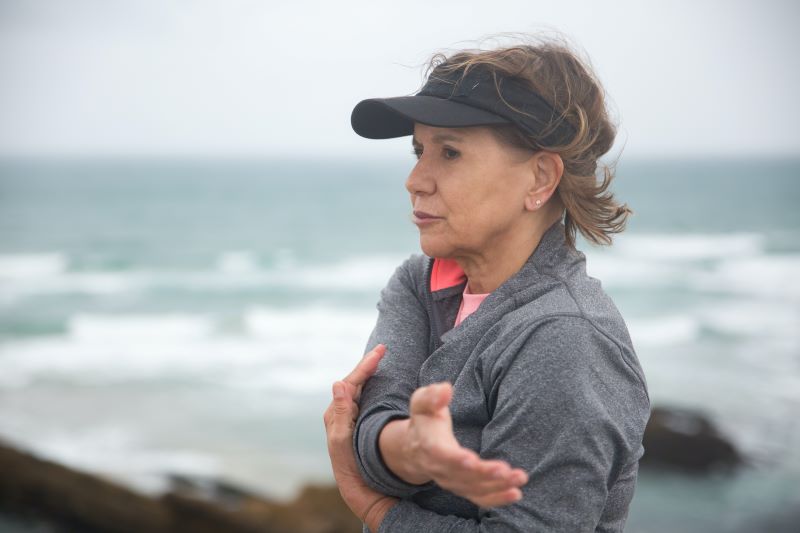
Thinning bones aren’t normal with age, although it’s very common and affects more than 40% of adults aged 50 or older. (1)
Those beginning to lose bone density have a condition called osteopenia, which means that bones are weaker, but not brittle. If left untreated, it can progress to osteoporosis, a condition characterized by thin and weak bones vulnerable to fractures.
While both conditions require medical attention, they’re not a reason to avoid activity. In fact, avoiding regular movement and exercise could make your condition worse. People with low bone density should find safe ways to exercise because it can help rebuild bone and keep you healthy.
Below are 5 exercise tips for osteoporosis or osteopenia. But before you start any exercise regimen, check with your doctor or physical therapist to make sure certain exercises align with your unique treatment plan and are safe from any other coinciding conditions.
1. Prioritize Activities with Some Impact
This may sound counterintuitive, but your bones need to experience impact and force to stay strong. According to a scientific rule called Wolff’s Law, bones respond to force by building more bone to adapt to it. (2) That means applying some force through your bones, like walking or stomping, promotes bone growth.
While Wolff’s Law is applicable to all bones, people are different. The impact your bones can tolerate may differ from another’s bones. Those with osteoporosis may need to choose lower-impact activities than those with osteopenia or normal bone density, or else you’ll dangerously overload the bone and Wolff’s Law can’t take place properly.
Before starting any impact activity, you should discuss ideas with your doctor based on your specific bone density measurement to see what you should be able to tolerate. Some may need to stick with walking for some time while others can jump right into jogging or light plyometrics. But as bones adapt, you can progress to more forceful activities, as allowed by your doctor.
2. Swim Sparingly
Swimming is a great exercise, but if you have low bone density, it doesn’t challenge your bones enough to encourage Wolff’s Law. There’s almost no impact in water activities, which isn’t ideal for people with osteopenia or osteoporosis. You want some impact for bone growth, but swimming is almost a no-impact sport.
That being said, if you enjoy swimming, don’t remove it from your current regimen. Instead, supplement some days with above-water activities. You can also get creative in the water by adding impact movements. For example, if you’re not comfortable (or safe) jumping on dry ground, maybe jumping in chest-height water is a good place to start.
3. Get Strong
Body-weight strengthening, like squats and wall pushups, are a great way to train your muscles for everyday activities. When muscles are strong and coordinated, they help protect your bones and reinforce your joints.
It’s important to note that bones are connected to muscles through tendons. When you contract a muscle, the tendon pulls on the bone to move your arm or leg. And as we already know, creating force through bone (like contracting your muscle and pulling the tendon) may encourage Wolff’s Law and promote bone growth. (3)
4. Practice Your Balancing
Perhaps one of the most important tips of all, you must practice stabilizing yourself through balance exercises. Not only does this help prevent falls and subsequent fractures, it also helps coordinate and strengthen muscles around your core (and low back), hips, knees, ankles, and feet.
Balancing exercises can build your confidence when you start performing more impact activities, like light jogging or jumping. You’ll feel much safer performing these activities and trying new ones if you feel coordinated and stable.
5. Avoid Unpredictable Impact Activities
Low-impact activities are safe for most, but impact sports should be avoided unless approved by your doctor. That’s because others may collide with you, creating unpredictable impact situations that are hard to protect yourself from. This may also include other types of unpredictable impact activities, like off-roading on rugged terrain or boating on rough seas.
But if you work on low-impact training, strengthening, and balancing, you may condition yourself to tolerate heavier activities, if cleared by your doctor.
Reach Out!
Consider these exercise tips for osteoporosis and osteopenia and ask your doctor what’s most appropriate for your treatment plan.
If you’re looking for additional guidance, ask your doctor for a physical therapy referral. Reach out to JACO Rehab for more information. We’d be happy to see you!
Written by Nicole Hernandez, DPT
Sources
1. Sarafrazi N, Wambogo EA, Shepherd JA. Osteoporosis or low bone mass in older adults: United States, 2017–2018. National Center for Health Statistics. 2021. https://dx.doi.org/10.15620/cdc:103477
2. Rowe P, Koller A, Sharma S. Physiology, Bone Remodeling. StatPearls. January 2023. https://www.ncbi.nlm.nih.gov/books/NBK499863/
3. Hong, A. R., & Kim, S. W. Effects of resistance exercise on bone health. Endocrinology and Metabolism. November 2018. https://synapse.koreamed.org/articles/1108823